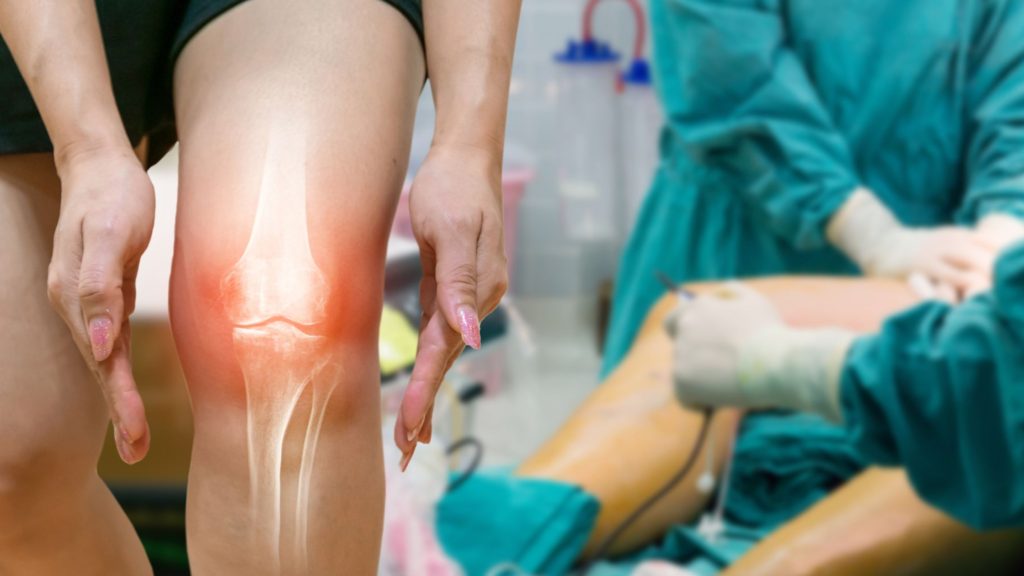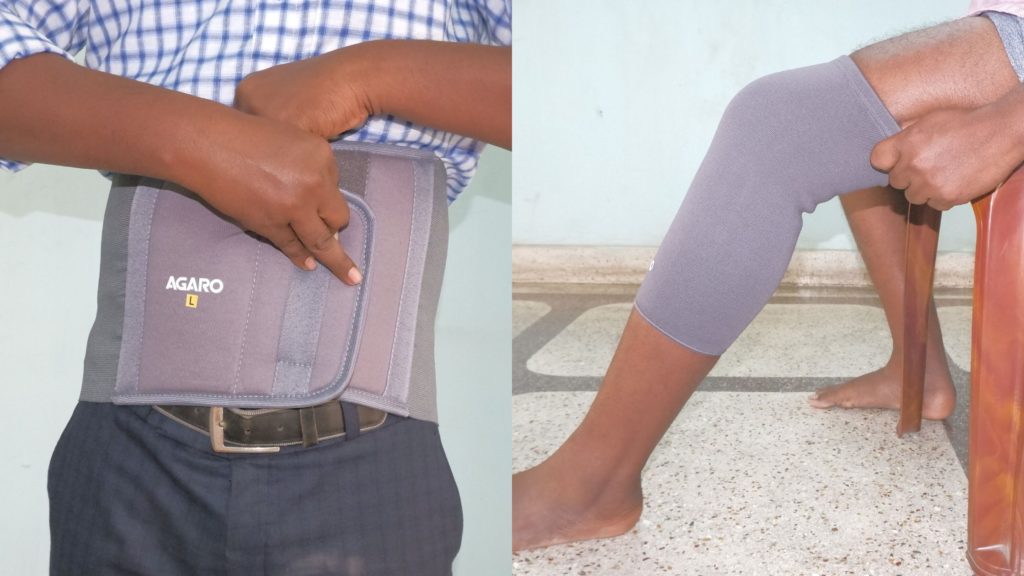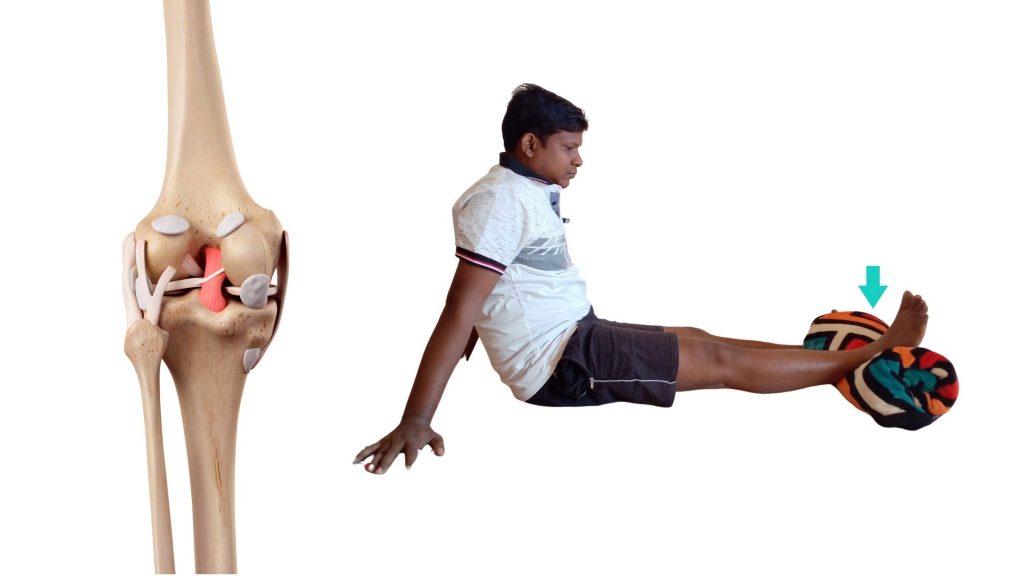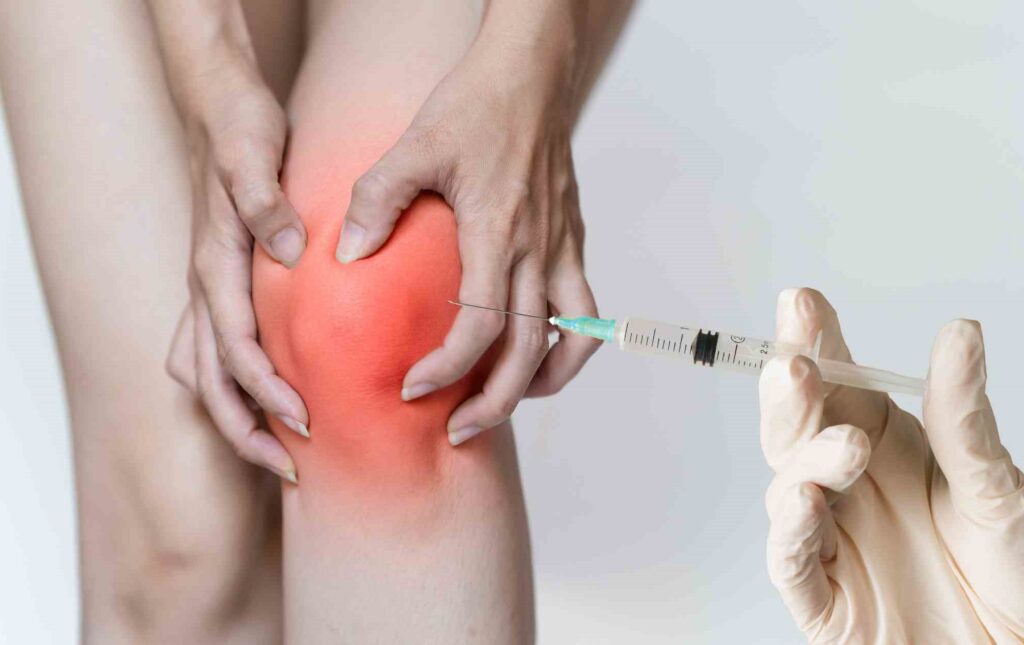Last updated on March 4th, 2025 at 06:51 pm
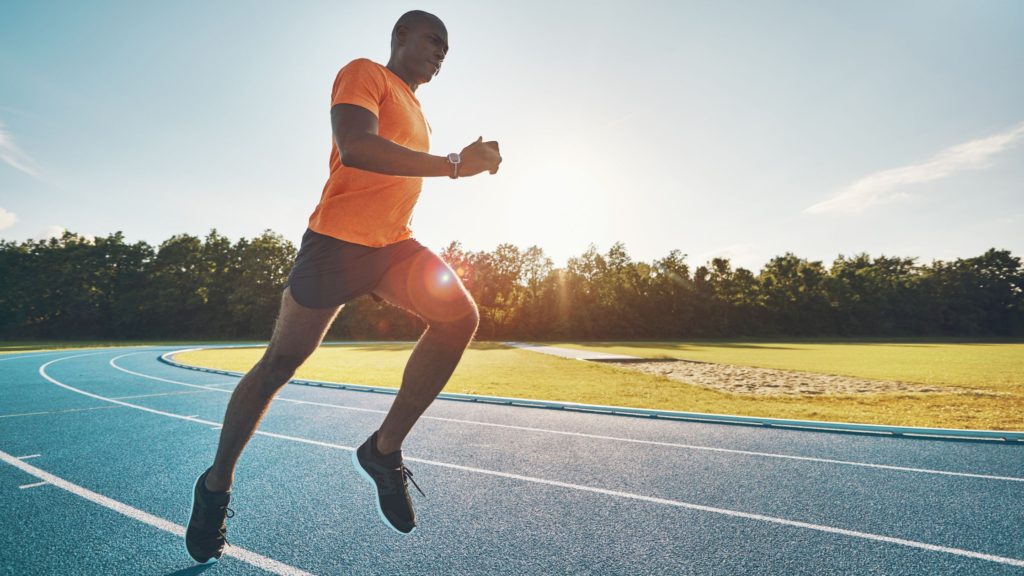
After ACL surgery, the question may also arise in your mind when can I run after ACL surgery? There are 5 criteria that you must fulfil to start initiating running and get back to work.
So to give a precise answer to this question, we have with us Dr Manu who is an orthopaedic surgeon and an expert in ACL surgery, In his opinion, we will know when we can start running. And I will explain to you how you can achieve running through exercises.
5 Criteria for initiating running after ACL surgery
In ACL (Anterior Cruciate Ligament) injury, two types of surgery can be performed depending on the grade of a tear. For incomplete tears, ACL repair is the choice of surgical procedure and for complete tears, ACL reconstruction is done1. Among them, ACL reconstruction is the most common.
So whether it is a reconstruction or a repair, the main concern of an athlete is when they can initiate running and get back to the sport as early as possible. For initiating running, you need to fulfil 5 criteria for your operated knee.
For both types of surgery, there are two techniques:
- One is conventional screw fixation and
- another is the fibre tape internal brace technique.
The fibre tape internal brace surgical technique is a new procedure that gives more strength to a newly reconstructed ligament2.
So in both conditions for complete healing, until the ACL becomes absolutely strong can take about six months, which is called ligamentization. That means your ligament is getting converted from tendon to ligament after reconstruction, so it takes 6 months to become strong.
As far as running is concerned, when you have undergone conventional surgery and now your question is when to start running, then after six months the running program starts.
But after six months not everyone can run. You need to fulfil some criteria only after that you can start running after six months, you can practice slowly.
If those criteria are not being fulfilled, then you have to work to meet those 5 criteria, after that, you have to start running practice. On the other hand, if surgery is done with a fibre tape internal brace then your new ACL is fixed with an internal brace made of fibre tape.
Because of this, you start the running program in three months and not six months, so running starts quickly in it.
Criteria#1: Knee should be able to come to complete straight
The first criteria is that your knee should go completely in extension. It means the knee should be able to come completely straight. Due to long-term immobilisation, the stiffness of the knee is the most common issue after the removal of the brace.
Knee extension stiffness is very common in which there are problems with full knee extension. So to achieve this you need to perform knee flexor stretching exercises.
Knee stretching exercise
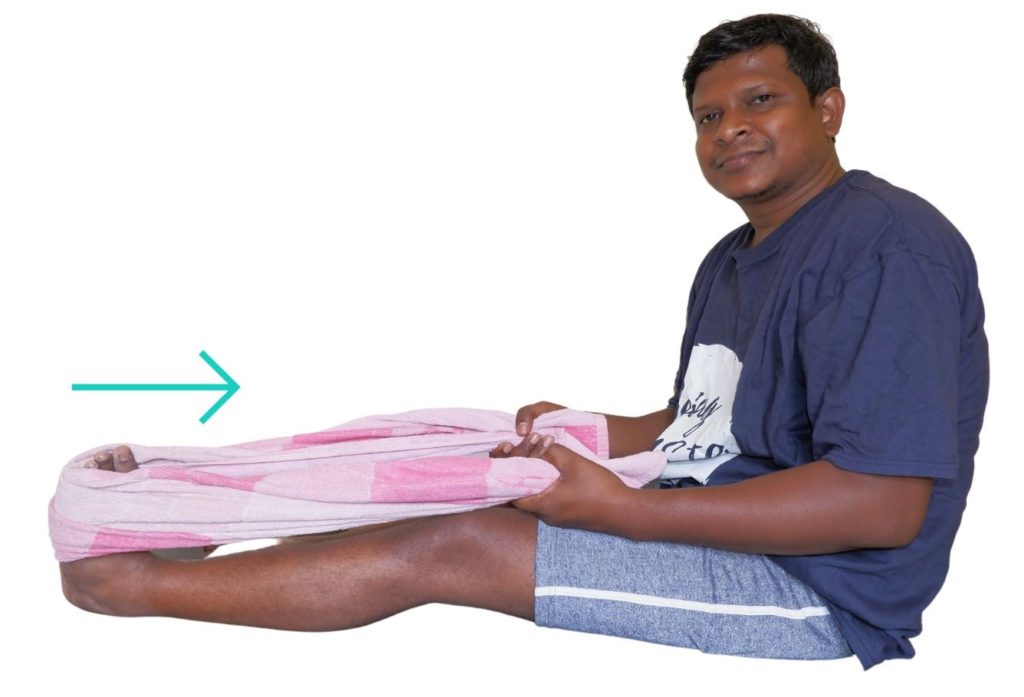
- For this exercise, you need to sit in the long sitting position with your leg as straight as possible.
- Take a towel or a bed sheet and place the mid part on the ball of the toes and hold the two ends with your hands.
- Now you have to pull the bedsheet towards yourself so as to allow the ankle to go for dorsiflexion, pull it to a point where you can feel comfortable stretching on your calf muscle and on the backside of your knee joint.
- Hold this position for a minimum of 30 seconds to 1 minute and then release it.
- Repeat this same process two to three times in a single session.
This stretching exercise stretches the muscles on the back of the knee which is important to gain full knee extension. So you have to repeat this exercise twice daily for the more you do the better it is.
Criteria#2: No swelling in knee
Second, there should no swelling in your knee. You have to make sure that there is no swelling and inflammation around the need. For this regular knee, exercises are very important. In addition to this, you can also apply an ice pack with compression.
Criteria#3: Knee bending of 110o angle or more
Third, your knee bending should be 110 degrees or above not less than that. The normal full range of knee flexion is 130 degrees, in our third criterion to initiate running is you should be able to bend to a minimum of 110 degrees of an angle.
Fibre tape internal brace fixation gives you the freedom to initiate knee-bending exercises from the very next day of surgery. You have to start with some light exercises and then progress to a more aggressive one.
Passive knee bending
So let us start with knee bending exercises in a long sitting position.
- In the long sitting position again you have to take a folded bed sheet hold the two and place the mid part over the foot.
- In this position pull the bedsheet towards yourself so as they allow passive knee bending.
- Bring knee bending to a point where you feel restriction, at this end range give slight overpressure by pulling the bedsheet, hold for 5 seconds and then again straighten it back.
- Repeat the same process 10 to 20 times in a single session twice daily.
Wall squatting
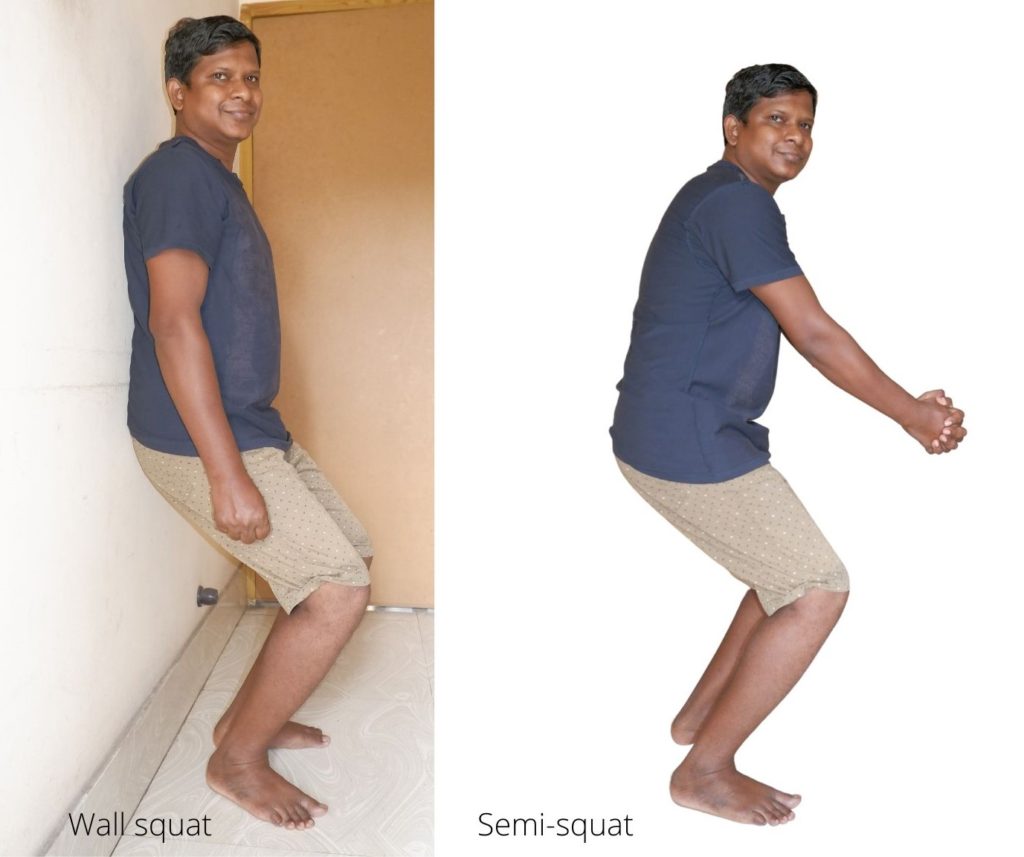
As you gain the knee range of motion you can progress the exercises in standing position, in standing position we can start with the wall squatting exercise.
- For this exercise stand with your against the wall and rest your back on the wall.
- In this starting position slide yourself down taking the support of the wall to come to a semi-squatting position. Lower down till to a point you feel pain with restriction in the affected knee.
- Give slight overpressure at this end range and then again come to a straight standing position.
- Repeat the same procedure 10 to 20 times in a single session.
Semi-squatting exercise
As you feel that you can you are improving with this exercise now you can progress to semi-squat exercise without any support.
- Stand straight with your feet apart and then come to a semi-squat position till your knee bending allows.
- At the end-range gives slight overpressure.
- Then come back to the normal standing position.
- Repeat this process 10 to 20 times in a single session.
Criteria#4 Should be able to single-leg squat
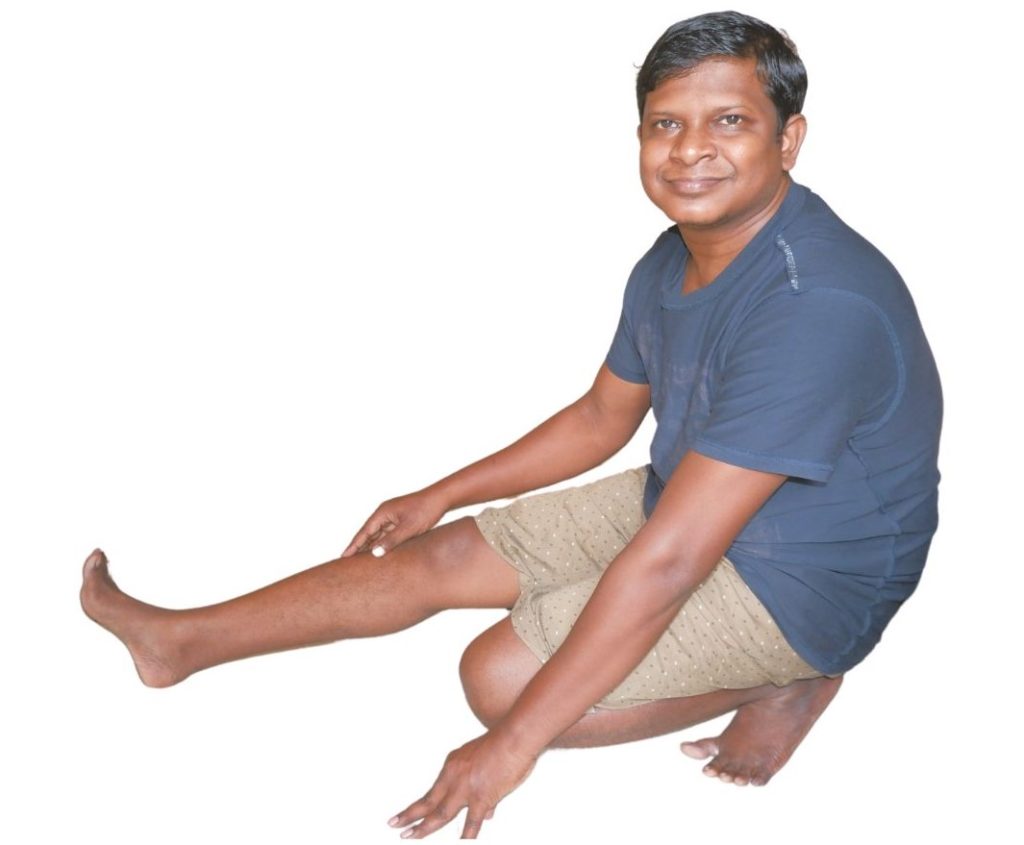
Fourth, when you do a single-leg squat, there should be no compulsion in a single leg squat, which means you should be able to do a single leg squat comfortably, your leg should not move to the varus or valgus, it should be an absolutely straight single-leg squat.
Criteria#5 No pain in the knee
Fifth point, the pain in your knee should be absolutely negligible, which means, it should be less than two. So the final criterion to start initiating running one should be able to come to single leg squat without any compulsion or without any pain.
Single leg squatting position needs very strong leg muscles and knee muscles. So if you are able to do this exercise that means you have gained enough strength of muscles around your knee and leg.
Conventional reconstruction vs Internal brace surgery
So, if you fulfil these five criteria and it has been six months since your screw surgery or it has been three months to internal brace surgery, then you can start running. But to fulfil these criteria your muscles should be very strong.
So, after conventional screw surgery, because the ligament is weak for the first six months and because there is no support inside, then rehabilitation is slow. You can not do weight bearing on legs from the first day of surgery, you delay the exercises, and delay in knee bending, because of that your muscles become weak, and then you will be able to do running when your muscles become strong.
So once in conventional screw surgery, the muscle is very weak because of prolonged rest period during which there should be no knee bending, use of knee brace and use a walker and avoid weight bearing.
This rest period makes your muscle weak and degenerate making it difficult for you to go back to spots or running and you have to work very hard to gain back muscle strength.
Secondly, if we slowly progress with knee bending that can often result in increased chances of developing knee stiffness as we have to achieve knee bending slowly in three months.
Some surgeons rest the knee in a brace, which prevents the complete bending of knee with the brace is on, that also increases the chances of your knee becoming stiff. So, these are some factors that prevent you from achieving knee bending.
On another hand, if surgery is performed with the internal brace technique because the reconstructed ligament is given protection inside, one can walk with full weight bearing from the very next day, with an external brace applied.
This prevents muscle weakness, and when your muscles do not become weak and start getting strong from the first day, as we have initiated knee bending from the first day, weight-bearing walking is initiated from the first day itself, and from the first day onwards lots of exercises are initiated.
So, at the end of the third month, your muscle will be so strong that you can fill these criteria and you can initiate running. If we achieve knee bending and complete knee extension then the chances of developing knee stiffness decrease.
Table of conventional ligament surgery vs internal brace surgery
| Aspect | Conventional reconstruction | Internal brace surgery |
| Muscle Strength | Weak muscles due to restricted movement and weight-bearing delays. | Preserves muscle strength with immediate weight-bearing and early exercises. |
| Rehabilitation Progress | Delayed exercises and slow knee bending. | Early mobility and exercise initiation from the first day. |
| Muscle Condition | Muscle weakness and degeneration due to prolonged rest. | Muscle strength preserved from day one, reducing the need for muscle recovery. |
| Return to Sports | Requires significant effort to regain muscle strength. | Faster recovery and readiness to meet running criteria by the third month. |
| Knee Stiffness Risk | Increased risk due to slow knee bending progression. | Lower risk with early knee extension and bending initiation. |
Other effective exercises
The exercises we discussed below are specific to achieve the particular criteria, however, to gain overall knee muscle strength and range of motion one must follow other effective exercises as well.
These exercises are aimed at preventing knee stiffness, maintaining range of motion and gaining strength. We have already covered these exercises in one of my dedicated articles “Ligament Injury of Knee? Follow These 7 Easy Exercises for Quick Healing” which you can visit and learn those exercises.
The author is a physiotherapist who has been practising for the last 17 years. He holds a Bachelor's in Physiotherapy (BPT) from SVNIRTAR (Swami Vivekananda National Institute of Rehabilitation and Research), one of the prestigious physiotherapy schools in India.
Whatever he learns dealing with his patient, he shares it with the world through blogs and e-books. He also owns a YouTube channel, "Sunit Physiotherapist" with over 8 lakh active subscribers. Here, he shares everything he gets to learn serving the patient.

Dr Manu Bora
An expert in arthroscopic surgeries of knee, shoulder, ankle, and sports medicine, Dr. Manu Bora is one of the few surgeons in Delhi NCR India who practices all Inside ACL and PCL reconstruction with fibre Tape internal bracing.
Dr. Bora uses the most highly advanced and latest technology in ACL surgery that ensures instant recovery wherein the patient can walk pain-free without the support and bend the knee just a day after the surgery as opposed to the conventional technique that is painful and results in slow recovery.
With countless successful surgeries to his credit, Dr. Bora has mastered Total and Partial knee Replacement, Total Hip and shoulder Replacement, and cartilage transplant. He also has commendable expertise in knee multiple ligaments and complex shoulder surgeries. Various awards and appreciation for excellence bestowed upon him stand proof of Dr Bora’soutstanding performance in orthopedic and sports medicine.
In the wake of serving the society selflessly, Dr. Bora regularly engages in taking free sessions on injury prevention and increasing endurance in sports for athletes, CRPF, BSF, and police and dedicates ample time at sports clubs and government sports authorities for the same. He also takes free office ergonomics sessions in various companies.
Education & Qualifications
Top Asthroscopic Doctor in Gurgaon, Mumbai, Jodhpur, Bangalore
Dr. Manu Bora’s expertise and experience in orthopedic and sports medicine are an extension of his wide range of qualifications that include:
- MBBS – S.N Medical College, Jodhpur, Rajasthan
- M.S (Orthopedics) – Grant Medical College, Mumbai, Maharashtra
- Senior Residency – Sports Injury Center, Safdurjung Hospital, New Delhi
- Fellowship in Shoulder surgery from Istituto Clinico Humanitas, Milan, Italy
- Fellowship in Sports Medicine and Arthroplasty from Hospital Ambroise Pare, Paris
- Fellowship (Sports Medicine)- Hospital for Special Surgery, New York. Senior Residency from Sports Injury Centre, Safdurjung.
Expertise :
Procedures:
- ALL INSIDE ACL/PCL RECONSTRUCTION WITH FIBER TAPE INTERNAL BRACE
- PERCUTANEOUS CARTILAGE, LIGAMENT, TENDON REGENERATION
- Shoulder Arthroscopy ROTATOR CUFF AND BANKART REPAIR
- Knee Arthroscopy and Ligament Reconstruction
- Ankle Arthroscopy
- Cartilage Transplantation
- Fracture and Musculoskeletal Trauma Surgery
- Total and Partial Knee Replacement Surgery
- Hip Replacement Surgery
Memberships:
- International Society of Arthroscopy, Knee Surgery, and Orthopedics Sports Medicine (ISAKOS)
- Asian Arthroscopy Society
- Indian Orthopedic Association
- Indian Arthroscopy Society
- Indian Association of Sports Medicine
- Indian Federation of Sports Medicine
- Delhi Orthopaedics Association
Awards and Recognitions
- Dissertation completed, “Comparison between different procedures for internal fixation of fracture Metacarpal”.
- Best Sports Injury Expert in Delhi NCR – 2018.
- Innovative Orthopaedics and Sports Injury Surgeon of the Year – 2019
- Indian Healthcare Excellence Award – 2019
- Nations Pride Award – 2020
- Most Inspiring and Successful Sports Injury Surgeon – 2020
